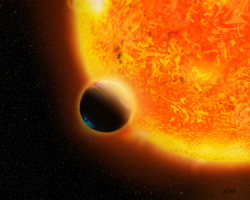Astronomy:HAT-P-6b
 Size comparison of HAT-P-6b with Jupiter. | |
| Discovery | |
|---|---|
| Discovered by | Noyes et al. |
| Discovery date | October 15, 2007 |
| transit | |
| Orbital characteristics | |
| 0.05239+0.00080 −0.00082 AU[1] | |
| Eccentricity | <0.044[1] |
| Orbital period | 3.852985±0.000005[2] d |
| Inclination | 166±10 °[3] |
| Star | HAT-P-6 |
| Physical characteristics | |
| Mean radius | 1.33 ± 0.06 |♃|J}}}}}}[2] |
| Mass | 1.106+0.039 −0.040[1] |♃|J}}}}}} |
| Mean density | 583 kg/m3 (983 lb/cu yd)[1] |
HAT-P-6b is a transiting extrasolar planet discovered by Noyes et al. on October 15, 2007.[2] It is located approximately 910 light-years away[4] in the constellation of Andromeda, orbiting the star HAT-P-6. This hot Jupiter planet orbits with a semi-major axis of about 7.832 gigameters, and takes 92 hours, 28 minutes, 17 seconds and 9 deciseconds to orbit the star.[2] It has true mass of 5.7% greater than Jupiter and a radius 33% greater than Jupiter, corresponding to a density of 0.583 g/cm3, which is less than water.[1]
The planet HAT-P-6b is named Nachtwacht. The name was selected in the NameExoWorlds campaign by the Netherlands, during the 100th anniversary of the IAU, after Rembrandt's painting The Night Watch.[5][6]
The sky projected angle between stellar and orbital axis is roughly 166°, making it one of the few planets that is in a retrograde orbit around its parent star.[3] Observations made by Spitzer Space Telescope shows that the planet atmosphere has a weak temperature inversion, or no inversion at all, depending on how strong is the stellar chromospheric activity.[7]
References
- ↑ 1.0 1.1 1.2 1.3 1.4 Bonomo, A. S. et al. (2017). "The GAPS Programme with HARPS-N at TNG . XIV. Investigating giant planet migration history via improved eccentricity and mass determination for 231 transiting planets". Astronomy and Astrophysics 602: A107. doi:10.1051/0004-6361/201629882. Bibcode: 2017A&A...602A.107B.
- ↑ 2.0 2.1 2.2 2.3 Noyes, R. W. et al. (2008). "HAT-P-6b: A Hot Jupiter Transiting a Bright F Star". The Astrophysical Journal Letters 673 (1): L79–L82. doi:10.1086/527358. Bibcode: 2008ApJ...673L..79N.
- ↑ 3.0 3.1 Hébrard, Guillaume; Ehrenreich, David; Bouchy, François; Delfosse, Xavier; Moutou, Claire; Arnold, Luc; Boisse, Isabelle; Bonfils, Xavier et al. (2011). "The retrograde orbit of the HAT-P-6b exoplanet". Astronomy and Astrophysics 527: L11. doi:10.1051/0004-6361/201016331. Bibcode: 2011A&A...527L..11H.
- ↑ Brown, A. G. A. (August 2018). "Gaia Data Release 2: Summary of the contents and survey properties". Astronomy & Astrophysics 616: A1. doi:10.1051/0004-6361/201833051. Bibcode: 2018A&A...616A...1G. Gaia DR2 record for this source at VizieR.
- ↑ "Approved names" (in en). http://www.nameexoworlds.iau.org/final-results.
- ↑ "International Astronomical Union | IAU". https://www.iau.org/news/pressreleases/detail/iau1912/.
- ↑ Todorov, Kamen O.; Deming, Drake; Knutson, Heather A.; Burrows, Adam; Sada, Pedro V.; Cowan, Nicolas B.; Agol, Eric; Desert, Jean-Michel et al. (2012). "Warm Spitzer Observations of Three Hot Exoplanets: XO-4b, HAT-P-6b, and HAT-P-8b". The Astrophysical Journal 746 (1): 111. doi:10.1088/0004-637X/746/1/111. Bibcode: 2012ApJ...746..111T.
External links
- "HAT-P-6 b". Exoplanets. http://media4.obspm.fr/exoplanets/base/planete.php?etoile=HAT-P-6&planete=b.
Coordinates: ![]() 23h 39m 05.8061s, +42° 27′ 57.513″
23h 39m 05.8061s, +42° 27′ 57.513″
 |


